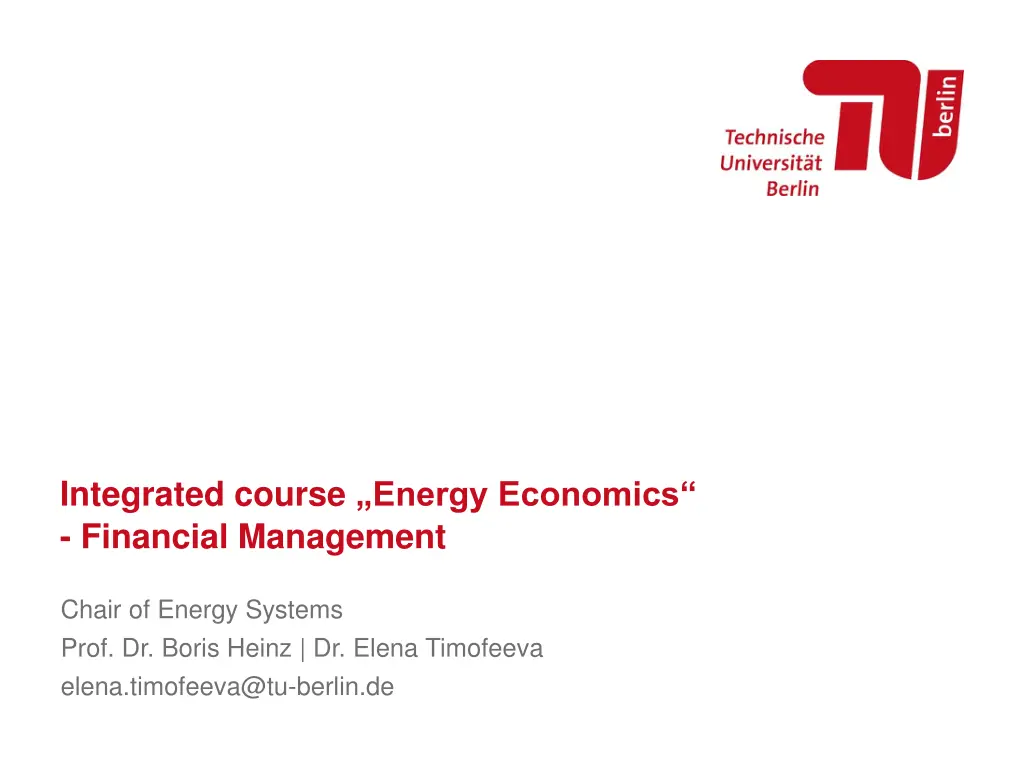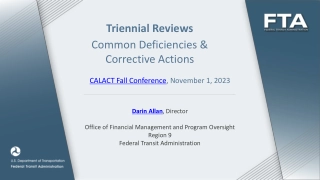
Energy Economics and Financial Management
Explore the fundamentals of finance, including balance sheet models, time value of money, capital budgeting, and more in the context of energy economics and financial management. Learn about the concept of Levelised Cost of Electricity (LCOE) and its significance in comparing different energy technologies. Dive into investment analysis comparing a PV system in Germany and Spain, evaluating NPV and LCOE, and implications for self-consumption of generated electricity.
Download Presentation

Please find below an Image/Link to download the presentation.
The content on the website is provided AS IS for your information and personal use only. It may not be sold, licensed, or shared on other websites without obtaining consent from the author. If you encounter any issues during the download, it is possible that the publisher has removed the file from their server.
You are allowed to download the files provided on this website for personal or commercial use, subject to the condition that they are used lawfully. All files are the property of their respective owners.
The content on the website is provided AS IS for your information and personal use only. It may not be sold, licensed, or shared on other websites without obtaining consent from the author.
E N D
Presentation Transcript
Integrated course Energy Economics - Financial Management Chair of Energy Systems Prof. Dr. Boris Heinz | Dr. Elena Timofeeva elena.timofeeva@tu-berlin.de
Outline Fundamentals of finance: Balance sheet model of the firm Time value of money: Compounding, discounting, annuity Capital structure and cost of capital Capital budgeting: NPV method NPV vs IRR Levelised cost of electricity (LCOE) Real options Seite 2
Levelised cost of electricity (LCOE) lifetime costs divided by lifetime electricity output Lifetime costs: PV of total cost of building and operating LCOE allows comparison of technologies regardless of lifetime, installed capacity, cost of capital, risk and return. initial capital cost* * specific investment costs: investment costs divided by capacity annual operating expenses capacity factor discount rate operational life Seite 3
Task 3) NPV and Levelized Cost of Energy (LCOE) The table below describes the investment conditions for a 5 kWpeakPV system in Germany and in Spain: Description Specific investment costs Operation and maintenance (O&M) costs Full load hours Capacity Lifetime Interest rate Germany 1 500 9 900 5 20 3 Spain 1 500 9 1 500 5 20 3 Unit /kWpeak /kWpeak/a hours/a kWpeak a % a) What is the Net Present Value (NPV) of the investment in Spain and in Germany, given a feed-in tariff (FIT) of 11.83 ct/kWh? b) What are the levelised cost of electricity (LCOE) of the photovoltaic system in Germany and in Spain (LCOE = electricity generation costs in ct/kWh based on full costing)? c) Assume that electricity retail prices in Spain and Germany are 29 ct/kWh. What does your result in b) imply for the self-consumption of the generated electricity? Slide 4
Description Specific investment costs Operation and maintenance (O&M) costs Full load hours Capacity Lifetime Interest rate Germany 1 500 9 Spain 1 500 9 Unit /kWpeak /kWpeak /a hours/a kWpeak a % Task 3) NPV and Levelized Cost of Energy (LCOE) 900 5 20 3 1 500 5 20 3 The table describes the investment conditions for a 5 kWpeakPV system in Germany and in Spain: c) Assume that electricity retail prices in Spain and Germany are 29 ct/kWh. What does your result in b) imply for the self-consumption of the generated electricity? The PV system operator is at the same time an electricity consumer (prosumer). The operator has an option to cover their electricity demand either from a supplier at the retail price (and feed the electricity generated in the PV system into the grid), or the electricity generated in their PV system (self-consumption). In simplified terms, given the retail price of 29 ct/kWh, the PV system operator should choose self- consumption. We may revisit this question to cover additional aspects in one of the coming classes. Slide 5
Task 4) Investment appraisal There are two power plants as investment options. The data is given below: Natural gas power plant 900 55 585 8 20 66 60 000 4 22 56 4 000 Hard coal power plant Units Capacity Efficiency Investment costs Interest rate Lifetime Employees Labor costs O&M costs Fuel price Emission factor fuel Full load hours 900 43 900 8 20 140 60 000 8 14 92 5 500 MW % Million % a Number /a/employee Million /a /MWhth kg CO2/ GJth hours/a a) b) c) d) e) f) What are the specific investment costs in /kW of the two options? What are the (short-term) marginal generation costs? What are the annual capital costs? What are the total annual fixed costs per MW installed? What are the levelised cost of electricity (LCOE)? What must the full load hours of the natural gas power plant be so that the long-term marginal generation costs are equal for both technologies? Slide 6
Natural gas power plant Hard coal power plant Units Capacity (Cap) Efficiency (?) Investment costs (I0) Interest rate (i) Lifetime (T) Employees Labor costs O&M costs (O&M) Fuel price Emission factor fuel Full load hours (FLH) 900 55 585 900 MW 43 % 900 Million 8 % 20 a 140 Number 60 000 /a/employee 8 Million /a 14 /MWhth 92 kg CO2 / GJth 5 500 hours/a Task 4) Investment appraisal 8 20 66 60 000 4 22 56 4 000 There are two power plants as investment options. a) What are the specific investment costs in /kW of the two options? b) What are the (short-term) marginal generation costs? Slide 7
Natural gas power plant Hard coal power plant Units Capacity (Cap) Efficiency (?) Investment costs (I0) Interest rate (i) Lifetime (T) Employees Labor costs O&M costs (O&M) Fuel price Emission factor fuel Full load hours (FLH) 900 55 585 900 MW 43 % 900 Million 8 % 20 a 140 Number 60 000 /a/employee 8 Million /a 14 /MWhth 92 kg CO2 / GJth 5 500 hours/a 8 Task 4) Investment appraisal 20 66 60 000 4 22 56 4 000 There are two power plants as investment options. c) What are the annual capital costs? Slide 8
Natural gas power plant Hard coal power plant Units Capacity (Cap) Efficiency (?) Investment costs (I0) Interest rate (i) Lifetime (T) Employees Labor costs O&M costs (O&M) Fuel price Emission factor fuel Full load hours (FLH) 900 55 585 900 MW 43 % 900 Million 8 % 20 a 140 Number 60 000 /a/employee 8 Million /a 14 /MWhth 92 kg CO2 / GJth 5 500 hours/a 8 Task 4) Investment appraisal 20 66 60 000 4 22 56 4 000 There are two power plants as investment options. d) What are the total annual fixed costs per MW installed? Slide 9
Natural gas power plant Hard coal power plant Units Capacity (Cap) Efficiency (?) Investment costs (I0) Interest rate (i) Lifetime (T) Employees Labor costs O&M costs (O&M) Fuel price Emission factor fuel Full load hours (FLH) 900 55 585 900 MW 43 % 900 Million 8 % 20 a 140 Number 60 000 /a/employee 8 Million /a 14 /MWhth 92 kg CO2 / GJth 5 500 hours/a 8 Task 4) Investment appraisal 20 66 60 000 4 22 56 4 000 There are two power plants as investment options. e) What are the levelised cost of electricity (LCOE)? Slide 10
Task 4) Investment appraisal There are two power plants as investment options. e) What must the full load hours of the natural gas power plant be so that the long-term marginal generation costs are equal for both technologies? Cfix NG Cfix coal STMGC NG STMGC coal 32,56 FLH coal 75.144 121.333 40 /MW/a /MW/a /MWh /MWh hours/a 5.500 Slide 11
LCOE of renewables and conventional generation at different locations in Germany in 2018 Source: Fraunhofer ISE Slide 12
What happened? Seite 13
What happened? FP by David Fracis Sep 28,2015: The decision to abandon oil exploration at the top of the world is at once both surprising and to be expected. It comes just two months after President Barack Obama signed off on Shell s operations off the coast of Alaska, and after the company defended its actions to environmental groups. Seite 14
Shell updates on Alaska exploration Sep 28, 2015 Shell today provides an update on the Burger J exploration well, located in Alaska s Chukchi Sea. The Burger J well is approximately 150 miles from Barrow, Alaska, in about 150 feet of water. Shell safely drilled the well to a total depth of 6800 feet this summer in a basin that demonstrates many of the key attributes of a major petroleum basin. For an area equivalent to half the size of the Gulf of Mexico, this basin remains substantially under-explored. Shell has found indications of oil and gas in the Burger J well, but these are not sufficient to warrant further exploration in the Burger prospect. The well will be sealed and abandoned in accordance with U.S. regulations. [ ] "Shell continues to see important exploration potential in the basin, and the area is likely to ultimately be of strategic importance to Alaska and the US. However, this is a clearly disappointing exploration outcome for this part of the basin. Shell will now cease further exploration activity in offshore Alaska for the foreseeable future. This decision reflects both the Burger J well result, the high costs associated with the project, and the challenging and unpredictable federal regulatory environment in offshore Alaska. Source: www.shell.com Seite 15
Real options Cash flows used for calculation under NPV method are future projections and, thus, estimated values. Uncertainty determining the risk of a project may be resolved during its lifetime. Flexibility to react to changes is part of investment evaluation. Financial options theory has been applied to physical investments. Option is the right to buy [or sell] the underlying asset at a specified price during [or at] a specified time. Option holder pays option premium to option writer. Seite 16
Real options: Valuating managerial flexibility A real option is a right, but not an obligation, to do something for a certain cost within or at a specific time. Source: He, 2007. Options to make adjustments to the project once it is accepted based on new information: - delay investment until an uncertainty disappears (timing option) - expand or reduce the scale of the project - change the input or output of the project - abandon the project if a pessimistic scenario materialises Example: oil or gas field with production costs exceeding the current oil/gas price but still valuable with a view to a potential future rise in the price. Seite 17
Real options: Compared to NPV method NPV method: more uncertain assets have relatively less economic value riskier investments are penalised by higher discount rates. Real options theory: uncertainty means not only possibility of future loss but also opportunity to create value from flexibilities by adapting the project to evolving conditions. Energy projects: long time horizons large amounts of capital high uncertainty Valuation complexity vs. Way of thinking Seite 18
Oil drilling problem: Bayesian decision theory Consider the problem faced by an oil company that is trying to decide whether to drill an exploratory oil well on a given site. Drilling costs are $200.000. If oil is found, it is worth $800.000. If the well is dry, it is worth nothing. However, the $200.000 cost of drilling is incurred, regardless of the outcome of the drilling. Suppose that the oil company estimates that the probability that the site has oil ( Wet ) is 40%. Decision State of nature Wet 600T 0 0,4 Dry -200T 0 0,6 Drill Do not drill Prior probability Source: M. Hillier Seite 19
Real options: Expected pay-off Probability Pay-off if successful Probability of failure Pay-off if failure Expected pay-off = x + x of success In reference to the waste truck excercise in a previous class: Annual revenue from truck operation of 120.000 is an expected value. Alternative 1: 80.000 /a Alternative 2: 120.000 /a Alternative 3: 140.000 /a 0,167 0,5 0,333 EV = 80.000 * 0,167 +120.000 * 0,5 + 140.000 * 0,333 Seite 20
Decision tree method Decision tree method is used for modelling sequential decision problems under uncertainty. Decisions mutually exclusive and collectively exhaustive set of possible alternatives of courses of action mutually exclusive and collectively exhaustive set of possible outcomes (states of nature) with assigned probabilities. The sum of probabilities in a set of events is equal to one. sum of costs and revenues associated with an alternative Events Payoffs Seite 21
Oil drilling problem: Decision tree solved (rolled-back) 1. At an event node, calculate the probability-weighted average payoff (EV). 2. At a decision node, choose the branch with the highest EV. Payoff [Drill]: 600*0,4 + (-200)*0,6 = 240 120 = $120T Payoff [Do not drill]: $ 0 Drill Source: M. Hillier Seite 22
Oil drilling problem: Advanced decision tree Source: Seba, 2008 Seite 23
Uncertainties in oil drilling Oil and gas upstream industry is characterised by sequential investments. Source: Jafarizadeh, Bratvold, 2009 Seite 24
Real options: Application examples Oil and gas exploration and production projects Developing a new technology high R&D cost and risk Change in regulation, e.g. climate policies future CO2 price Seite 25






















